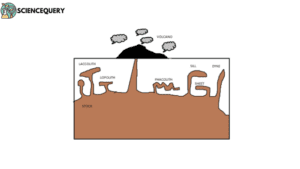
Introduction
Rocks are an aggregate of minerals. Sometimes they are composed of single mineral species like rock salt and limestone. But more commonly consists of two or more different minerals. Rocks are widely classified as igneous rocks, sedimentary rocks, and metamorphic rocks. This article is about one such rock type known as Lopolith. These types of rocks come under igneous rocks and are saucer-shaped in appearance.

Rocks can be classified as follows

- The word igneous comes from the Latin word “Ignis” meaning fire. They are formed by the solidification of molten materials. All igneous rocks are liquid. They are also called “parent rocks “or primary rocks as all other rocks are derived from them.
- Igneous rocks are basically of four types where extrusive and intrusive are the prominent ones. One major part of intrusive igneous rocks are Lopolith.
- Lopolith is a saucer-shaped intrusive igneous rock which as opposed to a phacolith, is concave upwards. The word lopolith has been derived from the German word “Lopas” meaning a shallow basin or bowl shape body
- It is more funnel-shaped than saucer-shaped; in other words, a lopolith has a shape that resembles a funnel.
Geological origin and formation

Intrusive rocks are those rocks that were formed through the solidification of molten rock material beneath the earth’s surface. However, the depth at which these rocks form varies from one place to another. If the magma solidifies at great depth, the intrusive rocks thus formed are called Plutonic rocks. Some intrusions which fail to reach the surface and solidify at intermediate depth, are called hypabyssal rock.
When magma is injected and solidified in a concave shallow basin whose central part is sagged downward, the resultant form of solidified magma creates lopolith.
The rocks of lopolith are generally coarse-grained because of the slow process of cooling magma.
Characterization and composition of Lopolith
- These are saucer-shaped
- They have flat and convex bottom
- They are very humongous with a diameter of approximately 240 km.
- A lopolith is funnel-shaped and occupies a large basin
- A saucer-shaped or concave shape is a shape that is curved outward.
- It is believed that igneous rocks were formed during each period of the geological history of the earth.
- Lopoliths are continuous landforms that is they are still being formed.
- They are hard, massive, and compact
- These rocks are free of fossils
- They are not easily weathered
- They are quite rich in minerals
- There are no pores, hence water penetration is not possible.
Classification
There are no notable subtypes of lopolith as they themselves fall under the classification of igneous rock bodies.
Geological significance and application of lopolith
- Lopoliths fall under igneous rocks that have been formed as a result of the solidification of magma which is a great source of metal ores.
- The minerals of great economic value found in them are magnetic iron, nickel, copper, lead, zinc, chromite, tin, mica, manganese, and rare ores like gold, diamonds, and platinum.
- These are of great value in the metallurgical industry these days. Granites and basalt are used as building materials.
- The basalt rock has weathered into black soil known as regur.
- This is very rich soil and is useful for the cultivation of cotton along with other crops.
Importance of lopolith related to Earth’s history
Intrusive igneous rock types such as lopoliths and laccoliths are formed by the solidification of magma chambers that were underground volcanoes and are exposed later to erosion subsequently. Other types such as mafic are found in ophiolite complexes which are portions of oceanic crust that have been uplifted and emplaced into continental areas through tectonic processes.
Origin of lopoliths
A few notable locations where lopoliths are found are:
- The Skaergaard Complex of Greenland
- Humboldt lopolith of Nevada
- The Sudbury Igneous Complex of Ontario
- The Bushveld igneous complex of South Africa
- The Great Dyke in Zimbabwe
Conservation and protection of Lopoliths
It is very important to conserve and protect these various intrusive igneous landforms. Though the work of denudation is a continuous process that will affect the landforms through the passage of time, conserving them where needed is the priority of the hour.
Human activities such as mining, grazing of livestock, and eco-tourism should be practiced in a sustainable way in places where these landforms are found.
Q&A
1. What is Lopolith?
Lopoliths are produced when the intruded magma pushes down the underlying strata forming a saucer-shaped intrusive igneous rock.
2. What is an example of Lopolith?
One example of lopolith is Duluth gabbro in Northern Minnesota.
3. What is the difference between lopolith and phacolith?
The primary difference between lopolith and phacolith is that the former is concave in shape while the latter is convex.
4. How is lopolith formed?
When magma is injected and solidified in a concave shallow basin whose central part is sagged down, it forms solidified magma known as lopolith.
Summary
- The material of the crust or lithosphere is generally called rocks.
- Rocks are basically classified into three types: Igneous, Sedimentary, and Metamorphic.
- Igneous rocks are further classified into intrusive and extrusive igneous rocks.
- Lopoliths fall under the intrusive igneous rocks which get created due to the cooling and solidification of magma inside the earth’s surface.
- It depicts the shape of a shallow basin or bowl.
- They are coarser in texture.
- Lopoliths take a long time to form as the cooling speed of magma while forming them is slow.
- Lopoliths occupy a tectonic basin.
- They are found in various regions of South America, South Africa, Greenland, Asia etc.
Website reference
https://en.wikipedia.org/wiki/Lopolith
